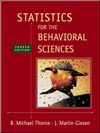 |  Statistics for the Behavioral Sciences, 4/e Michael Thorne,
Mississippi State University -- Mississippi State
Martin Giesen,
Mississippi State University -- Mississippi State
Measures of Central Tendency
Chapter Overview| Central tendency is the trend for scores in a distribution to be concentrated near the middle of the distribution. The measures of central tendency discussed in the chapter are the mean, the median, and the mode.
The mode is the most frequently occurring score in a frequency distribution. The mode is abbreviated Mo; a distribution with two modes is called bimodal, and both values are reported.
The median (Md) is a point along the score scale separating the top 50% of the scores from the bottom 50%. The median is the score value at the 50th percentile, with percentile defined as the score at or below which a given percentage of the scores lie. The procedure detailed for finding the median is the counting method.
The counting method is used for locating the median in a frequency distribution or in a simple array of scores ranked from highest to lowest. First, the total N is considered. If N is odd, the median is the score in the middle. For example, if there are 9 scores, the median will be the 5th score because there are 4 scores below it and 4 scores above it. If the total N is even, the median will be halfway between the two scores in the middle. Thus, if there are 10 scores, the median will be halfway between the 5th and 6th scores because there are 4 scores below the 5th and 4 scores above the 6th.
The mean (for a sample, µ for a population) or arithmetic average is the sum of the scores divided by the number of scores. The mean is often called the balancing point in the distribution because if we sum algebraically all of the positive and negative deviations about the mean, the result is zero; that is, the positive and negative differences about the mean are in balance.
Four rounding rules are given in the chapter: (1) Round everything to hundredths; (2) if possible, round only the final answer; (3) in all preliminary calculations leading up to the final answer, maintain at least three decimal places; (4) if the digit in the thousandths place is less than 5, drop it and everything that follows it; (5) if the number in the thousandths place is 5 or more, round the preceding digit up.
The mode is the best measure in three instances: (1) when you need the quickest estimate of central tendency, (2) when you want to report the most frequently occurring score, or (3) when you have nominal scale data. The median is preferred when (1) you have a small, badly skewed distribution, or (2) there are missing or arbitrarily determined scores. The mean is the most useful of the measures of central tendency because many important statistical procedures depend on it. Also, the mean is the most stable of the measures from sample to sample. The sample mean is an unbiased estimate of the population mean.
In a symmetrical, unimodal distribution, the mean, median, and mode all have the same value. The mean is pulled in the direction of the tail in a skewed distribution, and the median will be between the mean and the mode. |
|



 2003 McGraw-Hill Higher Education
2003 McGraw-Hill Higher Education